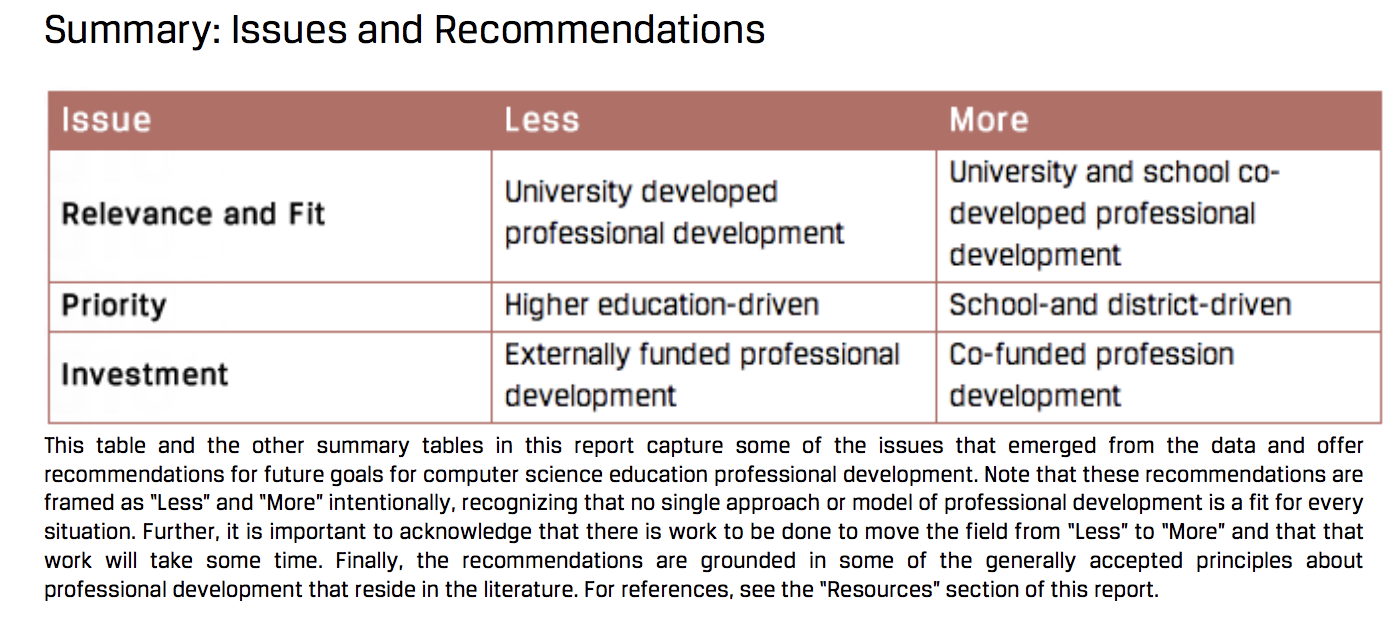
In 2012, the Outliers group at the University of Chicago completed a national landscape survey on the state of computer science (CS) education in the U.S. It’s still available here. One of their findings was that teacher professional development worked differently in computer science education than for any other subject. In all other subjects, individual school districts ordered professional development and paid for it. In 2012, most CS teacher professional development was paid for by the National Science Foundation or Google and was delivered from local universities. The University of Chicago authors suggested that this was a significant problem, and changing from a university-driven to district-driven “co-funded” model was one of their recommendations.
From the 2012 Landscape Survey
I remember when I first saw the report presented at SIGCSE, and this recommendation stunned me. There was so little CS education in the United States at that time! If you put it on the districts to pay for it, it simply wasn’t going to happen. Districts aren’t going to pay for something that might not be wanted or needed. They have so many other things to pay for.
In 2013, Code.org began, and they changed the face of CS education in the United States. It started out as just a video (linked here, seen over 14 million times), and grew into an organization that created and provided curriculum, offered teacher professional development, and worked with states and districts around public policy initiatives. A recent report from Code.org showed that 44 states have enacted public policies to promote computing education in the five years from 2013 to 2018, and much of that happened through Code.org’s influence.
Code.org famously paid for all CS teacher professional development. They report that 80,000 primary and secondary school teachers received opportunities to learn to teach computer science without paying any fees. That was critical to get a toehold for computer science in the United States. Code.org’s completely free CS teacher professional development meant that they bore the risk. Districts didn’t have to gamble their scarce funding on teaching computer science, when they didn’t know that it would be worthwhile. Would these CS courses become important in the district and in the state? Would parents want this? Would students take the courses?
But it’s also a problem when Code.org bears all the risk. The districts bear no responsibility. They have no ownership. Education in the United States is locally-controlled, and decisions are decentralized. If Code.org (or NSF or Google) are paying for all the development of CS teachers, then the districts don’t get to say, “In our community we care about this and we care less about that.” The US education system is organized around the local regions calling the shots, setting the priorities, and deciding what they want teachers to teach.
Now, Code.org has announced that they are starting to scale back their funding, which begins a multi-year transition to shift the burden of paying for teacher professional development to the local regions. This is a big deal. Six years after the U. Chicago Landscape Survey, we are moving to the recommended model, the way that most subjects are supported in the United States. The districts will call the shots.
The only question is whether it’s too soon. Will local regions step up and demonstrate that they value computer science by paying for it? Is there enough computer science in the schools that the districts will want to sustain it? Code.org is making the change gradually, with an awareness of where there’s more support for bearing the burden and where there’s not.
I’d guess that many states have between 40% and 70% of their high schools now offering computer science. However, even though many schools offer computer science, there are still few students taking computer science. Here are two sample data points:
- The University of Texas-Austin STEM Center has released a report of how many students are in each of the state’s 16 computer science classes in every Texas high school. There are actually 20 reports, one per region, available here. I recommend skimming through the reports. Many schools have students in one course. Few schools have students in two courses. Very few high schools have more than that. The numbers in those courses are shockingly small. Just look at Region 1 (which has higher CS participation than many regions): 54 of 159 high schools in the region offer computer science, and only 2.3% of their students have ever taken a computer science class.
- Indiana released a landscape survey of their state a year ago (see link here). They report that their most popular CS course in the state enrolled only 0.4% of Indiana high school students. The second most popular course enrolled 0.2%. Anne Leftwich presented aa map of the 2017 data at the annual ECEP meeting this last week showing where CS students are located in Indiana — see link here. Most schools only offer a single section of any CS course (many with fewer than 10 students in the class), and there are large swaths of Indiana with no CS at all.
Code.org’s timing on turning over the funding and responsibility to the districts may be perfect. Many districts have a CS program, but it’s fledgling. It’s up to the local education agencies to grow their programs. They have to figure out the incentives that bring in more students and that get principals to offer more CS courses and more sections of courses. This is where we have to close the gap in CS education in the U.S., between the national organizations and state governors’ offices that are promoting CS education, and the interest from parents in having CS education for their children. In that gap are the district administrators and school principals who have yet to buy in. In the highly-distributed U.S. education system, that gap is closed at the local level.




Join the Discussion (0)
Become a Member or Sign In to Post a Comment